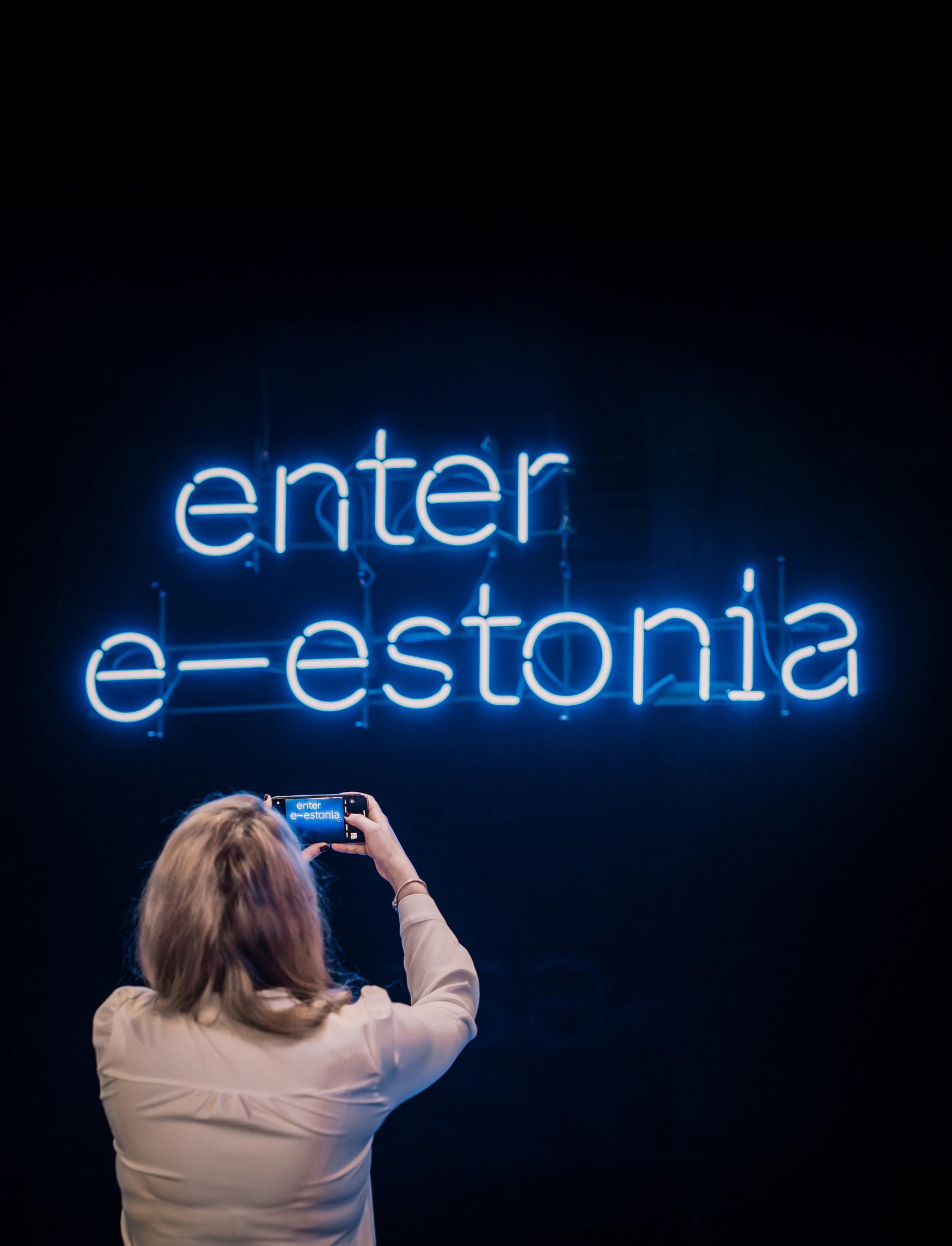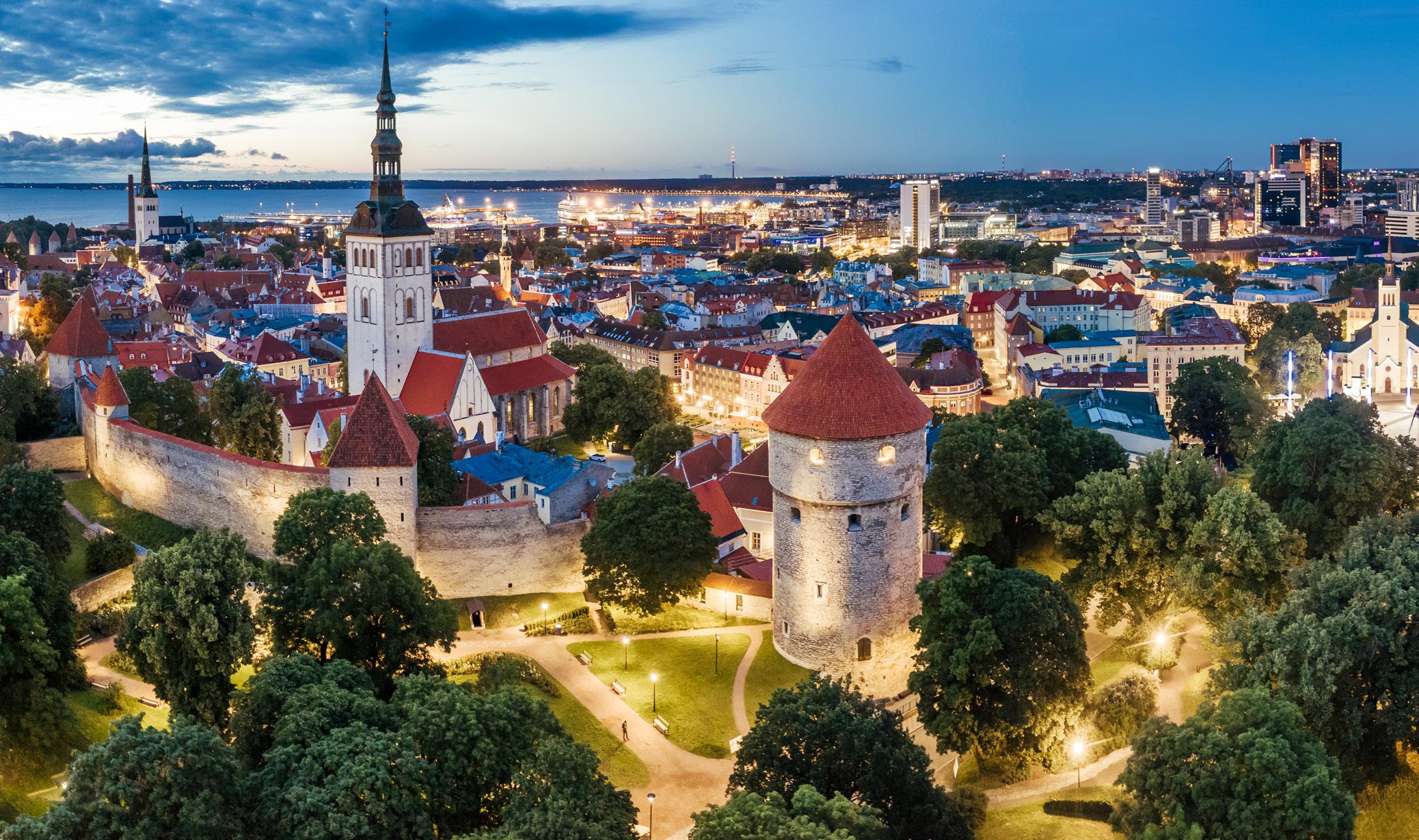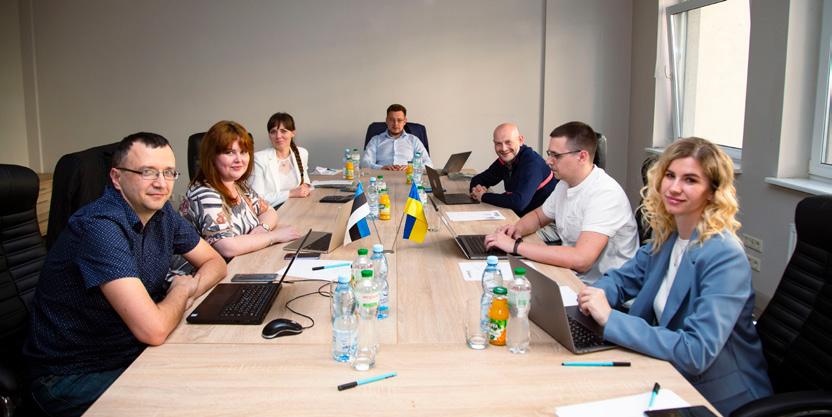

AMONGST THE WORLD’S MOST ADVANCED DIGITAL SOCIETIES




AMONGST THE WORLD’S MOST ADVANCED DIGITAL SOCIETIES

Despite only having a population of around 1.37 million, Estonia ranks amongst the world’s most advanced digital societies
Writer: Jack Salter | Project Manager: Ben Weaver
The rise of Estonia into a digital powerhouse has been made possible by the pioneering advances made under e-Estonia.
Solutions and services created through this government initiative include e-health, e-education and research, e-identity, e-governance, and much more.
Estonia is a global leader in the former, with the Estonian National Health Information System connecting healthcare providers nationwide and securely storing patients’ medical data in one centralised platform, where 99 percent of the country’s health records are digitalised.
Decades of digitalisation have resulted in a society where everything can be done digitally, and the future brings more personalised and proactive services for Estonia.
By ensuring equal access to technology in education,
meanwhile, the country continues to bridge the digital divide.
Efforts include strengthening school internet infrastructure, providing teaching devices, creating digital learning materials, and enhancing teachers’ digital skills. Through strategic investments and a strong digital ecosystem, Estonia empowers students and educators alike, making digital learning accessible, resilient, and future-ready.
Every Estonian, no matter where they live, also has a state-issued digital identity known as e-ID, a cornerstone of the country’s e-state that enables secure digital transactions in both the public and private sectors.
Citizens use their e-ID daily to sign documents digitally, access healthcare records, manage banking and business,



vote online, and shop securely.
Moreover, since 2014, the country has offered e-Residency, a unique programme allowing non-residents to access Estonian e-services and build borderless businesses. Today, over 100,000 e-residents benefit from the country’s trusted digital ecosystem.
Digital signatures, which are saving two percent of Estonia’s GDP annually, also quicken public administration and reduce bureaucracy in the country without sacrificing trust or transparency, whilst identity wallets are championed. Such innovations serve to make digital identity more mobile, secure, and easier to use.
By fully integrating e-identity into daily life, Estonia has created a secure, efficient, and inclusive digital society that sets the global standard.



Elsewhere, e-governance ensures 100 percent of the country’s public services are available online 24/7.
This seamless accessibility is made possible by a secure and citizen-centric digital ecosystem where transparency, efficiency, and trust are the cornerstones.
Thanks to e-governance, Estonia saves over 1,400 years of working time annually and provides a hassle-free environment for both businesses and residents.
The e-Estonia initiative also ensures cybersecurity, ease of doing business, interoperability, and smart mobility, further demonstrating the country’s leadership as a digital society.
Most importantly, all this is achieved in very close cooperation with the public-private sector, which has built the best digital society.

The vision of the Estonian Association of Information Technology and Telecommunications (ITL) is a smart Estonia and effective cooperation between the public and private sectors, as we discuss with Doris Põld, CEO
The other big part for us is to help other countries and organisations achieve world-class digital societies, sharing our e-Estonia experience with the world.
EO: What is your current take on the IT and telecommunications (telecoms) industry in Estonia and the growth of innovation in the country?
DP: The past years have been a little rough with different kinds of crises, but at the same time, they’ve been extremely interesting.
EME Outlook (EO): Firstly, please could you introduce us to ITL and your primary objectives?
Doris Põld, CEO (DP): ITL is an industry association with the core aim of protecting and representing our members. We gather the most innovative Estonian digital technology companies behind the e-Estonia story, which is quite well known around the world.
Altogether, there are almost 150 companies in our association. ITL represents the Estonian digital technology sector and their common opinion on how to boost the digital society and have a favourable legislative environment for our businesses to flourish.
Our sector has been growing very rapidly. Export numbers have been increasing, as has the number of companies and people working in the IT sector. One big reason for that is the new technologies in the market.
The other economic sectors are also understanding more and more that IT is an enabler of innovation. Cybersecurity is one of the core fields where we have seen the need for more development, as cybersecurity attacks in Estonia have been increasing over the years. That also means our capabilities in cybersecurity have increased and the sector’s companies are extremely important, particularly as we have strong competence in this area.
Another big part is the increasing use of artificial intelligence (AI) technologies in the public sector, which has also developed in recent years to build a nextgeneration digital society.
“IN SOME WAYS, I FEEL ESTONIA SETS A VISION FOR WHERE OTHER COUNTRIES SHOULD AIM, AND THIS IS SOMETHING WE ARE VERY PROUD OF”
– DORIS PÕLD, CEO, ESTONIAN ASSOCIATION OF INFORMATION TECHNOLOGY AND TELECOMMUNICATIONS
EO: How does ITL aim to become a leading technology operator in the region?
DP: We are the leading technology organisation in Estonia as we gather all the most innovative companies, and have very close cooperation in the region with similar kinds of organisations in neighbouring countries.
In some ways, I feel Estonia sets a vision for where other countries should aim, and this is something we are very proud of.

Firstly, introduce us to Introduct Group.
Introduct Group was founded in April 2016, with its pivotal growth starting in May 2017 in Kyiv, Ukraine. What began as a small team of five dedicated professionals quickly grew as we secured our first customers, some of whom remain partners to this day. By the end of 2017, our team size had doubled, and from those early days of passionate commitment, we’ve evolved into a robust international technology group.
Today, Introduct is a thriving organisation with over 150 full-time staff spanning eight companies across four countries: Estonia, Ukraine, UAE, and Oman, alongside active operations in Georgia.
We are proud to operate debt-free, with a group turnover exceeding €15million annually, a net profit of €1.5million, and strong liquid assets of €7million. Our financial independence allows us to invest continuously in innovation without compromising agility or integrity.
Our services and products are broad yet focused on quality and impact. We own and operate a fully private Tier 2 data centre in Tallinn, Estonia, equipped with proprietary telecoms infrastructure and a 24/7 in-house customer support center staffed by 10 professionals. This backbone enables us to provide end-to-end managed operations excellence, ensuring high availability and seamless support.
Our portfolio includes custom software development, ranging from legacy system modernisation, enterprise-grade mobile and web applications, to pioneering blockchain and AI solutions. We also offer specialised services like gaming development and business process automation. One of our flagship offerings is the Introduct boilerplate product, a customisable and scalable software skeleton that accelerates project delivery by providing essential core functions like customer portals, mobile apps, and back-office systems.
Beyond client services, Introduct runs the Impulse Generator Fund (IGF), a private equity fund focused on emerging technologies and start-ups.
We invest heavily in people through the Introduct Academy, our internal training programme that equips staff and clients alike with the technical skills required in today’s fast-evolving IT landscape.

What ongoing or recent projects are you most excited about?
We’re really excited about the incredible projects coming out of our R&D centers right now-it’s tough to pick just one without feeling like we’re leaving something amazing out!
One of the coolest things we’re working on is an AI-powered product with a key customer to revolutionise a critical government process that fuels the country’s finances. Right now, it takes eight people and eight months every year to get this job done. Our mission? Use cutting-edge AI models to automate it and cut processing time to minutes, bringing the manual work amount to nearly zero! We’re building and training complex AI models to deliver results that surpass the quality of the manual work done by seasoned and established economists. It’s game-changing stuff, and we’re thrilled to be part of it.
Another big win is expanding our training services to the Middle East this fall. After more than eight years in the region with our R&D services, we’re now bringing our top-notch training centres-previously only in Europe-to build a skilled, world-class workforce for our Middle Eastern clients. We can’t wait to see where this opportunity takes us!
What, for you, differentiates your business from the competition?
At Introduct, our core differentiators are financial independence, deep technological expertise, customer loyalty, and operational excellence.


First, our debt-free, cash-positive model ensures sustainable growth without external pressures.
Second, our diversified team is truly international, multilingual, and multidisciplinary, drawing talent from at least seven countries and speaking eight languages.
Third, we emphasise a personal, long-term partnership approach with every client. Retention rates are exceptionally high because we treat every customer as a valued collaborator, not just a transaction.
Lastly, our strategic investment arm, IGF, keeps us connected to the start-up ecosystem and cuttingedge technologies, allowing us to bring the latest innovations directly to our customers. This blend of services, investments, and internal capability development creates a unique ecosystem that few competitors match.
Could you tell us about some of the major challenges faced within the industry and the business itself, and then detail how these have been overcome?
The tech sector’s rapid evolution presents constant challenges, from technological shifts to geopolitical factors, especially given our significant operations in Kyiv, Ukraine. Political instability and economic uncertainty required us to build resilience and flexibility in our business model early on.
One challenge has been managing growth whilst maintaining quality and culture. We overcame this by investing heavily in internal training and quality assurance through the Introduct Academy and adopting strict operational protocols. This ensures consistency across all projects and keeps our team aligned despite geographic dispersion.
Another challenge is the integration of emerging technologies like AI and blockchain, which require


We are particularly focused on enhancing our global presence, with plans to enter new regions and strengthen existing partnerships. This expansion will be complemented by the introduction of new service offerings, designed to meet the evolving needs of our clients across diverse industries. Our ongoing investments in research and development, particularly in AI-driven solutions, will enable us to deliver greater value and efficiency to our customers.
The coming year is poised to be a pivotal chapter in our journey, and we are excited to embrace the opportunities that lie ahead.
Ukraine: +380 89 3202213
Estonia: +372 77 44 444
Oman: +968 7996 0136
UAE: +97145178420
E-mail: enquiry@introduct.tech
Website: www.introduct.tech

EO: Equally, how do you stand for the interests of ITL members, a competitive business environment, and the development of a digital society?
DP: What it means more precisely is that inside Estonia, one part is to build public-private partnerships (PPPs) and collaborate closely with the public sector to ensure legislations and regulations are more favourable for companies and to boost the business environment.
We are setting our digital society vision as a country together; it’s not something that is only done by the public sector.
It has been always very important to have these strong partnerships as we believe they have been one of our key success factors. We’re gathering a consolidated opinion of the IT sector from different companies and representing it to the public sector.
The other part is how we help to boost the digital society and share our experience with the world. We organise business visits for our companies at an international level and always help to build partnerships with like-minded organisations and countries.
We strongly believe that marketing together is more effective in many cases. As they’re small to medium-sized enterprises (SMEs), their scalability maybe isn’t as fast, so that’s why we do these kinds of things together.
EO: Could you tell us more about ITL’s Vision 2035? How will Estonia reach the forefront in digitalisation and serve as a model for others in the field?
DP: We believe that for our Vision 2035, we need three core pillars – a bold state, smart people, and a functioning
“WE BELIEVE THAT FOR OUR VISION 2035, WE NEED THREE CORE PILLARS – A BOLD STATE, SMART PEOPLE, AND A FUNCTIONING REAL-TIME ECONOMY”
– DORIS PÕLD, CEO, ESTONIAN ASSOCIATION OF INFORMATION TECHNOLOGY AND TELECOMMUNICATIONS
real-time economy. These are the three mainstays we need in order to achieve our aim.
A bold state for us means having the most user-friendly and secure environment for businesses and citizens and the most effective governance, especially in the digital field. That’s the focus for us; we want to promote innovation together with the government. We would like to see, as a small state, that we’re using AI tools in a smart way and automating routine work.
Smart people for us means that we need to think about how people are moving across borders in the future. It’s not only about Estonian people but about having the workforce we need in order to grow.
We need to think about how, in future, work-related regulations will change all over Europe because people are working across borders everywhere, and that’s what you need when you want to engage the best talent.
We also need the real-time economy to boost every economic area and the most secure digital solutions.




Cybersecurity is very important not only at government level but at private sector level for every company, and we need to use the data in the best and smartest way.
In the future, I think the companies that know how to use the data will be more competitive.
EO: How do you see the IT and telecoms industry in Estonia developing over the next five years?
DP: In the next five years, we will definitely be more export-oriented. Today, over 56 percent of our total income comes from exports; I think this number will increase even more in the future.
We still want to be a good environment for start-ups to scale and do business, and this is something we would like to boost.
The other part is the e-residency programme. I think the IT sector will grow even more, and the number of companies in it will increase.
Today, the IT sector’s contribution to total Estonian GDP is 11 percent. I think that after five years, this will be at least 15 percent, so our share in the economy will increase.
EO: Lastly, what are ITL’s key priorities in order to achieve your vision for a smart Estonia?
DP: One key priority is to have easy access to talent, especially IT specialists who have PhD degrees, for example, and also to increase the amount of foreign talent in the Estonian ecosystem.
Our other priorities are PPPs and to boost the Estonian digital technology sector’s innovation capabilities and to continue to promote our experiences in the world.
Tel: +372 617 7145 info@itl.ee https://itl.ee
